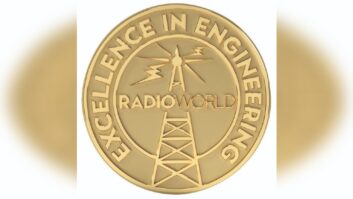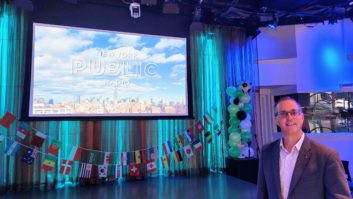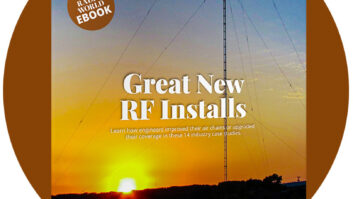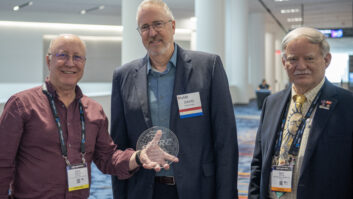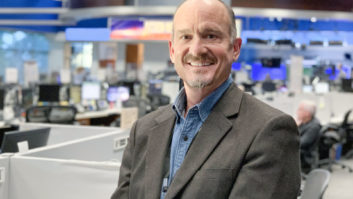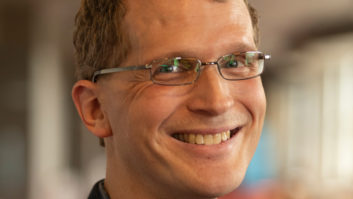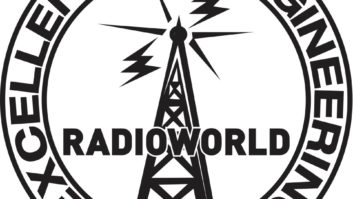Michael Starling is the recipient of the 2005 Radio World Excellence in Engineering Award.
(click thumbnail)NPR President/CEO Kevin Klose and Starling celebrated another honor, NPR’s recent ‘Cool Stuff’ Award for innovation in multicasting, at the network’s headquarters.
Recipients represent the highest ideals of the U.S. radio broadcast engineering profession and reflect those ideals through contributions to the industry. The award was presented during the NAB Radio Show in Philadelphia, where he also received a PR-40 large-diameter studio cardioid microphone courtesy of Heil Sound Ltd.
Starling got his first job in radio because he was persistent – and because he happened to walk into a station that had fired its entire air staff the day before. The program director was pleased that this ambitious 17-year-old held a Third Class FCC permit with broadcast endorsement – this was 1969 – and hired Starling for a Sunday shift at WBMD(AM/FM) in Baltimore.
But ask him how he got into radio and he’ll look back to the inaugural episode of “Outer Limits” in 1963 – the story of a chief engineer and station manager siphoning power away from the transmitter to communicate with a being in the Andromeda Galaxy.
“It was probably 20 years later before I realized that really ignited my imagination and led me into shortwave listening in junior high school,” he told me. “I quickly became a ham operator and was instantly mesmerized by the magic of sending voices and music through the air. I went in that direction straight away.”
He became president of the high school amateur radio club, working 113 countries in the middle of the night. Meanwhile, a ham friend was studying for his First Class Radiotelephone, hoping to get a job at a nearby station, and urged Starling to get his Third Class so he could work as a DJ. Starling, apparently not shy even then, called all the stations in town and landed the job at WBMD.
New job
Thirty-six years later, Starling, age 53, is among the top engineers in radio broadcasting.
As chief technology officer and vice president of engineering and operations for National Public Radio, he has been responsible in recent years for strategic technology, operations, audio engineering and engineering technology, overseeing a staff of more than 100, a $12 million annual operating budget and $2 million in annual capital projects. He has been principal architect of numerous NPR regulatory positions before the FCC.
He has a new title now; days after he received this award, NPR announced Starling’s promotion to chief technical officer and executive director for NPR Labs. That means he is “the primary visionary on technical policies at NPR on behalf of the member stations – helping chart a course for the future of public radio.”
But his impact goes beyond that. In fact you’d be pressed to name an engineer who has had more impact on radio, as an individual, than Starling in the past year.
He played a key role in the exploration of multicasting, one of the most important technology developments in U.S. radio right now. The Tomorrow Radio Project, of which he was architect, led directly to the exploration – by commercial and public stations alike – of airing multiple program channels in existing spectrum using digital radio technology.
Starling recently established NPR Labs, an advanced technology research and development center, at a time when the industry desperately needs more technical R&D. Readers will recall his Guest Commentary here (March 30) on the need for such a center.
He also launched an NPR certification mark for digital radio receivers; and he’s a leader in creating national “best operating practices” recommendations.
This is an engineer who tends to look further ahead than most. He also consistently has acted in the best interests not only of his employers but of the industry.
Many threads
His past accomplishments aren’t shabby either.
At age 24 he launched a radio station in Virginia, WKYY(AM). He got the idea while working as a copyboy for Broadcasting magazine. Opening the mail one day, he saw a flyer from an engineering consulting firm, Educational FM Associates, run by Ed Perry.
“I called him up and said, ‘I’ve always thought of having my own station, is there any chance of doing it?’ He was great and helped me,” Starling recalled. “That’s how I found Amherst, Va. Within a couple of years I found a frequency, got local funders and signed it on in 1976.”
Starling counts Perry among his most important influences; another is John Folsom, former DOE of KPBS(FM/TV) in San Diego, who “taught me a lot about standards, the real meaning of “good engineering practice” – making sure our exhibits into the commission were absolutely pristine and error-free.”
Along the way, Starling learned the value of a range of experiences. He holds a law degree and is admitted to the California, District of Columbia and Federal bars, which no doubt helps him in his public policy work.
For two years he was engineering operations supervisor for Mutual. He was a station chief for nine years at KPBS; he has been a DOE and the president of a consulting firm, AM/FM Associates. He also studied journalism/radio-TV at the University of Maryland.
I asked him if his studies in law and journalism are unusual for an engineer.
“Maybe it’s unusual to have those particular threads,” he said, “but most of the engineers I know have had experience in other realms; and it’s that practical experience – in other than the mysteries of the ether and electrons – that makes for good integrated engineers, well-grounded in business, programming and marketing as well. Most of your practical, hands-on chief engineers have done lots of other things.”
Starling has managed big projects. He implemented what was at the time the largest U.S. digital audio networking system using high-availability server architecture, serving users in Washington, Los Angeles and New York via a WAN. Among his greatest challenges was the 1994 move of NPR into its current building – “in four months and four days, on time and on budget, with no loss of airtime; quite a whirlwind of 20-hour days.”
His papers, articles and convention appearances are too numerous to list. Near to my heart, he has been active in supporting the International Association of Audio Information Services, for which I am a past board member. That organization of radio reading services honored Starling last year with its C. Stanley Potter Lifetime Achievement Award.
He and his wife Linda, a special education resource specialist, live in Maryland. He has two grown sons, Eric and Jeff.
Fun stuff
“As corny as it sounds, I truly find it to be gratifying and something of an honor to work in this part of the industry,” he said. “I love public radio and I love engineering.” I asked Mike how he would describe what he does at NPR. His brief answer: “All the really fun engineering stuff.”
Starling is upbeat about radio’s future, noting that billions of people use our medium around the world. Even though podcasting and satellite have made a dent in listening in the United States, he said, their total number of users remains a little more than one-tenth that of traditional radio.
“It’s from a position of strength that we get to embrace the new technologies.”
Still, Starling says, our industry must focus on protecting the integrity of its broadcast signals and remaining competitive with emerging technologies. “Only by having healthy signals and spectrum can we continue to reach the listeners we’ve built to serve.”
In the short term, he’s eager for the commission to approve multicasting for real, and for electronics companies to get receivers into the marketplace, “hopefully in the next few months.”
He’s also pleased to see an increasing number of younger folks at public radio engineering events. “Even though it’s largely a room of gray hairs, there’s increasingly lots of youngsters showing up who are intrigued by the tuning intricacies of final amplifiers as well as IT-based projects. These are signs of hope.”
He points to NPR’s Kyle Evans as an example of an eager, younger engineer. Evans was an intern in 2003 for NPR’s summer engineering projects and is now a technical research associate for NPR Labs.
Starling’s words of wisdom to someone interested in an engineering career: Motivation, perseverance and enthusiasm will carry you.
“If you’re really interested in it and you love it, don’t take no for an answer. Just keep knocking on doors until someone gives you a break.”
Radio engineering is fortunate that Mike Starling has knocked on a lot of its doors.






